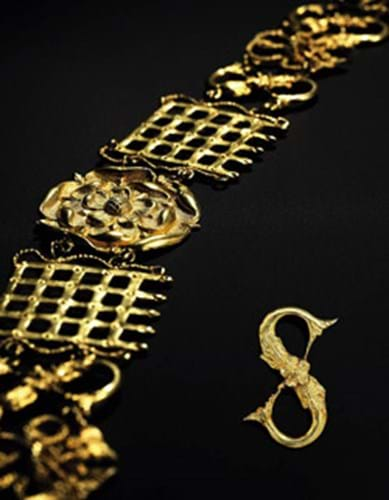
The piece is known as the Coleridge collar because prior to acquisition by the vendor it had descended through the family of Lord Coleridge, who acquired it in 1873 in his capacity as Lord Chief Justice of the Common pleas. It is thought that it is the livery collar or chain of office personally given by Henry VIII to Sir Edward Montagu, his loyal follower, which makes it the only surviving example from his reign.
As well as serving as Lord Chief Justice of the Common Pleas, in which post he was given this collar, Montagu (c.1485-1557) was a Privy Councillor, an executor of the King's will and governor to his son, later Edward VI.
Livery collars were first worn in Henry IV's reign as official symbols of allegiance to the monarch. Lancaster's kings favoured the motifs of 'S's, Yorkist kings used suns and roses. For their collars, the Tudor dynasty incorporated 'S's, the motif of a Tudor rose and portcullises, all of which feature in Sir Edward's collar detail shown here.
The collar would have been sold on to his successors as Lord Chief Justice of the Common Pleas right up until 1880 when Lord Coleridge merged that office with that of Lord Chief Justice of the Queen's Bench to create the role of Lord Chief Justice of England. It would then have become redundant, becoming Lord Coleridge's personal property.
A posthumous portrait of Sir Edward at Boughton House shows him wearing an identical chain. Moreover prior to the auction, the collar was subject to scientific analysis which revealed the gold to date from 1545-51 confirming its age and strengthening the hypothesis that this was indeed Montagu's chain.
When it was offered for sale as part of Christie's auction of early European furniture, sculpture and tapestries on November 6, it realised a mid-estimate £260,000, the top price of the day. The auctioneers said the chain would be going to a UK private collection.
By Anne Crane




